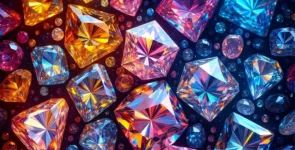Have you ever wondered how the sparkling gemstone in your favorite piece of jewelry made its way to you? From the depths of the earth to the display cases in jewelry stores, the journey of a gemstone is a fascinating and complex process. Understanding this journey not only enhances your appreciation of these beautiful stones but also helps you make informed choices when purchasing jewelry.
The Birth of a Gemstone: Mining and Extraction
The journey of a gemstone begins deep within the earth. Millions of years ago, extreme heat and pressure formed these precious stones, and today, they are extracted through mining. The mining process is the first step in bringing gemstones from the earth to the market.
Types of Mining
There are several methods of mining, each suited to different types of gemstones and geological conditions. The most common methods include open-pit mining, underground mining, and alluvial mining.
- Open-Pit Mining: This method involves removing large amounts of soil and rock to reach the gemstone deposits below. It is commonly used for mining diamonds, emeralds, and sapphires. Open-pit mining is efficient for extracting large quantities of gemstones but can have significant environmental impacts.
- Underground Mining: In underground mining, miners dig tunnels deep into the earth to reach gemstone deposits. This method is often used for gemstones found in deeper layers, such as rubies and certain types of diamonds. Although it is less disruptive to the environment than open-pit mining, underground mining can be more dangerous for workers.
- Alluvial Mining: Alluvial mining is used to extract gemstones from riverbeds and other sedimentary deposits. This method is particularly common for mining diamonds and sapphires. It involves washing away layers of soil to reveal gemstones, which are then collected by hand or with simple tools.
The Case of the Pink Diamond
The pink diamond, one of the rarest and most valuable gemstones, is often mined using open-pit or alluvial methods. The Argyle mine in Australia was one of the world’s primary sources of pink diamonds until its closure in 2020. The rarity and unique color of pink diamonds make them highly sought after, and their journey from mine to market is particularly intriguing.
Sorting and Grading: Assessing the Gemstones
After gemstones are extracted from the earth, they undergo a meticulous sorting and grading process. This step is crucial in determining the quality and value of each gemstone.
Sorting the Gemstones
Gemstones are sorted based on their type, size, color, and clarity. This initial sorting is often done at the mining site, where rough stones are separated into different categories. For instance, diamonds are sorted into industrial-grade and gem-quality categories. The latter category is further divided based on color, with pink diamonds being among the most prized.
Grading the Gemstones
Once sorted, gemstones are graded according to their specific qualities. Grading criteria include:
- Color: The color of a gemstone is one of its most defining characteristics. For example, the pink diamond is graded based on its hue, tone, and saturation. The deeper and more vivid the color, the higher the value.
- Clarity: Clarity refers to the presence of inclusions or flaws within the gemstone. The fewer inclusions a gemstone has, the more valuable it is.
- Cut: The cut of a gemstone affects its brilliance and how it reflects light. A well-cut gemstone, whether it’s a diamond, sapphire, or emerald, will have maximum sparkle and appeal.
- Carat Weight: Carat weight measures the size of the gemstone. Larger gemstones are rarer and often more valuable, but the other factors like color and clarity also play a significant role in determining the overall value.
Cutting and Polishing: Bringing Out the Beauty
Once gemstones have undergone the grading process, they are sent to skilled artisans who cut and polish them. This stage is where the raw beauty of the gemstone is revealed.
The Art of Cutting
Faceting: Faceting is a common technique used in cutting gemstones. This involves creating multiple flat surfaces, or facets, on the gemstone to reflect light and create sparkle. The number and arrangement of facets vary depending on the gemstone and the desired effect.
Cabochon Cutting: Some gemstones, especially those with a smooth, opaque appearance like opals and turquoise, are cut into cabochons. This involves shaping the stone into a smooth, rounded dome without facets.
Polishing the Gemstone
After cutting, gemstones are polished to enhance their shine and smooth out any rough edges. Polishing involves using fine abrasives to create a smooth, reflective surface. The polishing process is crucial in bringing out the gemstone’s true color and brilliance, making it ready for setting into jewelry.
Setting and Design: Crafting the Jewelry
With the gemstones cut and polished, the next step is setting them into jewelry. This stage combines artistry and craftsmanship to create beautiful and wearable pieces.
The setting is the part of the jewelry that holds the gemstone in place. The choice of setting depends on the type and size of the gemstone, as well as the overall design of the jewelry.
Designing the Jewelry
Jewelry design is where creativity meets craftsmanship. Designers consider the gemstone’s characteristics, including its color, cut, and size, to create a piece that complements and enhances the stone. Whether it’s a simple solitaire pink diamond ring or an elaborate necklace featuring multiple gemstones, the design process is crucial in transforming the gemstone into a piece of art.
Bringing Gemstones to Market
After the jewelry is crafted, it’s ready to be sold. Gemstones and jewelry go through several stages before reaching the consumer.
Wholesale and Distribution
Most gemstones and jewelry pieces are sold to wholesalers, who distribute them to retailers around the world. The wholesaler’s role is to connect jewelry makers with retail stores, ensuring a steady supply of products for consumers.
Retail Sales
Retailers are the final link in the journey of a gemstone from mine to market. Jewelry stores, both physical and online, offer a wide range of products to consumers. The retailer’s role is to present these gemstones in an attractive way, highlighting their beauty and value to potential buyers.
The journey of a gemstone from mine to market is a fascinating process that involves many skilled professionals and intricate steps. From mining deep within the earth to crafting beautiful pieces of jewelry, each stage is essential in bringing these precious stones to you.
Written by Harlow Sweeney








